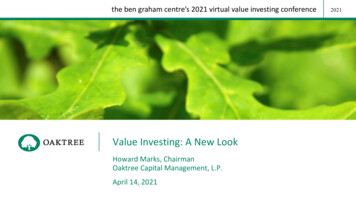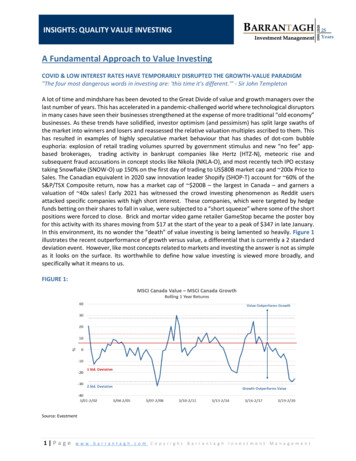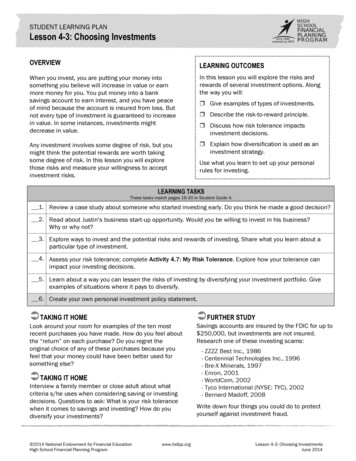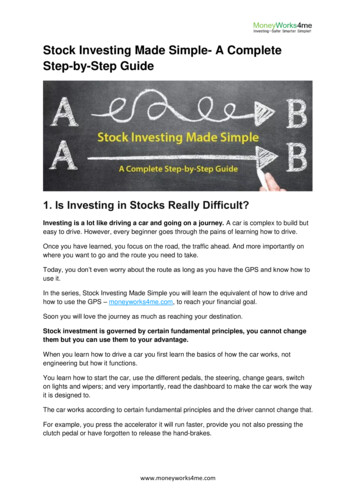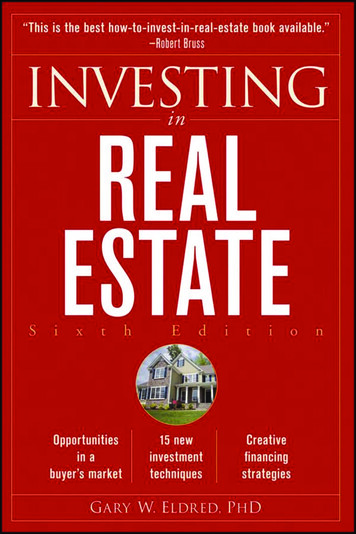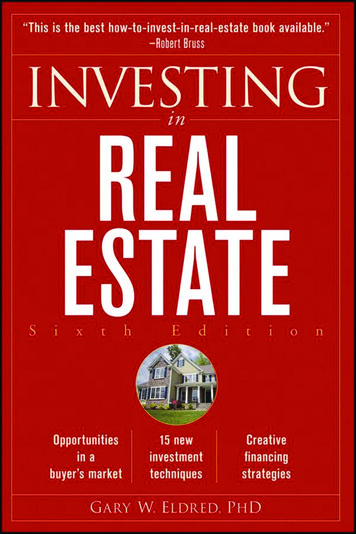
Transcription
Secrets of Residential InvestingHow to Build a MillionaireStudent Manualwww.mckissock.com
Table of ContentsLen Elder, JD, DREI, Senior Instructor & Curriculum Developer . 4Section 1: Understanding Principles of Investment . 5Why Clients Should Choose Real Estate as an Investment? . 8Benefits of Residential Real Estate Investments . 8A Lesson in Leverage . 9Teaching Clients to Think Differently . 10Market Conditions and Trends . 13Section 2: Concepts of Residential Real Estate Investment . 14The Concept of Cash Flow . 14The Concept of Equity & Appreciation . 15The Concept of Tax Advantages & Real Estate Investments . 16Allowable Expense Deductions for Owner Occupied Properties . 17Allowable Expense Deductions for Investment Properties . 17Understanding Depreciation . 18The Concept of Capital Gains . 19The Role of 1031 Tax Deferred Property Exchanges . 19Practical Applications of Residential Investing . 21Case Study: The Carolina Rental Cash on Cash Return . 21Determining Cash Flow & Return on Investment (Blank) . 22Determining Cash Flow & Return on Investment (Example) . 22www.mckissock.com2
Calculating the Equity Rate of Return (Blank) . 25Calculating the Equity Rate of Return (Example). 26Determining the Appreciation Rate of Return . 27Adding It All Up Expanded Rates of Return . 27Section 3: Understanding Flips & Fix Ups . 28Case Study: Beach Front Bonanza. 30Determining a Net Equity Position . 31Issues of Value & Appraisal . 32Issues of Management . 33The Story of John Jacob Astor. 35www.mckissock.com3
Len Elder, JD, DREI, Senior Instructor & Curriculum DeveloperLen Elder is the Senior Instructor and Curriculum Developer for Superior School of RealEstate. With over 25,000 hours of live classroom presentations and teaching, Len hasexcelled to the top of his field and is recognized nationally as an author, speaker, coursedeveloper and a Distinguished Real Estate Instructor (DREI) by the national Real EstateEducators Association. Len joined Superior School in the fall of 2013.With a B.A. degree in Speech Communications & Broadcasting and a law degree fromCapital University, Len brings a multi-disciplinary approach into the classroom. Hisprofessional life spans the private practice of law, the mortgage banking industry, the realestate profession and the educational profession. He has served on numerouscommittees, acted as the President of the Southern Arizona Mortgage BrokersAssociation, served as a Board member of the national Real Estate Educators Association and is one of sixelected people in the country who served on the Distinguished Real Estate Instructors Leadership Council.For 10 years Len was the Senior Instructor at Hogan School of Real Estate in Southern Arizona and after thatwas the founder and CEO of the national education company, Course Creators. Len is a noted author and haswritten over 100 educational courses for real estate professionals throughout the United States, published lawjournal articles, been featured as the cover author of the REEA Magazine and created the national textbook forthe training and development of instructors, Ovation – How To Present Like a Pro. Len regularly deliversInstructor Development Workshops and has acted as the instructor for the real estate commissions anddepartments in North Carolina, Arizona, Utah, South Dakota, Iowa, Oregon, Idaho, Alabama, Oklahoma andothers.He is a regular presenter at national conventions and events. Most of all he believes that educational classesshould be fun, exciting and he has dedicated his life to helping other people succeed.Recipient of the John Getgey Award for AcademicExcellence in the Practice of LawMortgage Broker of the Year, Tucson, ArizonaMarjorie Lewis Distinguished Service AwardPast Board Member of the National Real Estate Educators AssociationLeadership Council of Distinguished Real Estate InstructorsNoteswww.mckissock.com4
Section 1: Understanding Principles of InvestmentThey are perfectly legitimate questions to ask.1. How is wealth really accumulated?2. How did wealthy people get that way?3. Who holds wealth and what does investing in real estate have to do with all of that?4. Is investing in real estate really beneficial for my clients?5. What do the wealthy know that I don’t about residential real estate investment?Noteswww.mckissock.com5
A Harvard business professor asked 5,000 Americans how theythought wealth was distributed in the United States. He thencompared their responses with the actual wealth distribution. Theresults are surprising and insightful and relate directly to the conceptsof investing, saving and real estate acquisition.Forbes annually publishes the sources of the wealth for the country’s Top 400 wealthiest people. Rank thefollowing from 1-10 with number one being the primary source of wealth today and 10 being the lowest source ofwealth today:Media / EntertainmentTechnologyFashion & RetailDiversifiedManufacturingEnergyFinanceReal EstateFood & BeverageInvestment (Stocks & Options)Noteswww.mckissock.com6
When a word cloud is created that indicates the sources of wealth, the words“Investment” and “Real estate” appear prominently. Many Americans believethat most of the wealthy people attained that status because of who theyknew, what they inherited or the fact that they were wealthy when they grewup. The facts as reported by Forbes do not support this conclusion. TheBusiness News Daily and Forbes have both reported that: The vast majority of millionaires are self‐made86% of them were not wealthy growing upReal estate is a key part of all their portfoliosThe decision to invest in real estate is one that is well rooted in the history of real estate throughout the UnitedStates. Between 1926 and 1996, the annual average rate of return on real estate was 11.1%. There arenumerous factors that make investing in real estate an appealing alternative to many individuals.I think a good rate of return for a real estateinvestment would be:The National Council of Real Estate Investment Fiduciaries (NCREIF) is an association of institutional real estateprofessionals who share a common interest in their industry. They are investment managers, plan sponsors,academicians, consultants, appraisers, CPA’s and other service providers who have a significant involvement ininstitutional real estate investments. They come together to address vital industry issues and to promote researchon residential investing. They have estimated the average current annual cash on cash return for residential realestate investment to be 10.15%.Noteswww.mckissock.com7
Why Clients Should Choose Real Estate as an Investment?Among the factors that drive investors are a potentially high rate of return, a shift from low return investments, adesire to remove risk and maximizing leverage.Benefits of Residential Real Estate InvestmentsThere are many benefits for the investor in residential real estate. Among those benefits, and those which we willbe discussing throughout this course are all of the following: Potentially High Rates of Return. Real estate can carry a potentially high rate of return. Particularlywhen compared with other forms of investment, holding money in savings or purchasing CD’s or bonds. Shift from Low Return Investments. Investors seeking rates of return have lots of options. Typically,when an investor purchases real estate they are moving money from a lower rate of return to a higherrate of return. They obtain the largest return on a long‐term hold asset which is held with the intentionof producing rental income. This appreciation is tax free, until sold, and opportunities to defer thatincome exist. Desire to Minimize Risk. Although no investment is ever risk free, investing in real estate providescollateral and security to back up the investment. Other investment opportunities contain the potentialof losing everything. That is rare in real estate investments. Ability to Quantify the Investment. The ability to quantify and measure rates of return of the real estateasset is easier than with other types on investment and also gives the investor a measure of control thatseldom exists with other investments. Opportunity to Maximize Leverage.Noteswww.mckissock.com8
A Lesson in LeverageMost real estate investors understand the concept of leverage. Leverage is the ability to do more with less and issometimes referred to as the principle which allows us to invest using “Other People’s Money” (OPM).In order to better understand the concept of leverage as it relates to real estate and rates of return. Let’s simplify acomparison between two buyers. The first buyer has 100,000 of cash and pays 100,000 cash for a propertyand sells it a year later for 110,000. (Yes, we realize that we have omitted transaction costs, but it will allow us tocompare apples to apples in the example.) That investor realized a 10,000 return on their 100,000 investmentand achieved a rate of return of 10%.A second investor also has 100,000, but decides to put 10% down on the home, investing 10,000, and alsosells it a year later for 110,000. For his investment of 10,000 the investor realized a 10,000 profit and achieveda rate of return of 100% on his money.We could calculate all of the missing elements from the examples, but the contrast in rates of return is striking.The second investor of course had mortgage interest to pay, but he also took a tax deduction for that expenseand still had his remaining 90,000 to invest in other ventures.This is a goodexample of theconcept of leverageat work:Noteswww.mckissock.com9
Teaching Clients to Think DifferentlyA large part of our job as real estate licensees is to educate clients on the value and wisdom of investing in realestate. This means that as licensees we often have to encourage clients to think differently. Part of the reasonthat the video regarding Wealth Inequality in America is so poignant is because the top 1% does understand moreabout investing and particularly about investing in real estate than most Americans and our clients.In order to appreciate the difference in mindset of what the top 1% knows that most of our clients don’t know justask yourself some basic questions: When were you taught in math class about calculating investment rates of return?When were you taught about the benefits of residential real estate investing?When were you taught about interest rates and leverage principles?When were told any of the following:How to create a family and investing budgetHow to properly manage credit cardsHow PayDay loans really workWhat percentage of Americansdo you think understand thesethings? We are willing to bet it’sabout 1%.Noteswww.mckissock.com10
If we were not taught these things then neither were our clients. Working with potential residential real estateinvestors is an opportunity to educate them on all of the things they may have missed which have led to a greatinequality of wealth.Investors in residential real estate think differently.The average consumer doesn’t understand themotivations that drive an investor and instead, due torecent housing downturns have talked themselvesout of investing in residential real estate.Far too often in the current real estate market we findinvestors and occupying homeowners using 2005 or2006 as the benchmark year for their measurementof their real estate values. Typical comments include,“Do you realize how much I have lost on my home inthe last couple of years?” or “Look at how muchhome values have been destroyed.”The knowledgeable real estate professional working with and guiding investors knows that the overall story ismuch different. 2005 and 2006 were aberrations in the value of real estate, no matter which charts, trends orstatistics you want to use and the overall fact remains that over time real estate values have traditionallyincreased, it is only in the short term, speculative, over-leveraged aspect of real estate investing that risks weremultiplied. As a long term investment real estate has always been a sound investment.Each real estate investor comes to the table with their own objectives and agenda in mind. The reasons whyinvestors are making an investment in real estate can vary greatly and often encompass a myriad of justifications.However, for the practicing licensee in North Carolina it is important to identify exactly which motivation may bethe most important to any particular investor.Noteswww.mckissock.com11
We can break the priority elements down into three essential categories that underlie the motivation of mostinvestors. They are: Cash FlowEquity/AppreciationTax AdvantagesThough nearly all investors operate with a mixture of these priorities, there is usually one of the above prioritieswhich acts as the overall driving force for any individual investor.How would rank your priorities if youwere investing in residential realestate?Cash flowEquity AppreciationTax AdvantagesNoteswww.mckissock.com12
Market Conditions and TrendsAs with any market numbers vary greatlybased on location and thanks to today’stechnology, the practicing real estateprofessional has many tools to analyze indepth current market conditions and trends.While local MLS systems provide guidancethere are other tools that real estateprofessionals should be utilizing when workingwith investors in specific markets.Some additional resources available are: Market Trend Analyses Available on HouseHunt www.househunt.comTrulia www.trulia.comZillow www.zillow.comNational Association of REALTORS sThere is one more aspect of the current market of which real estate licensees should be aware. That is the factthat for a lot of investors, buying in the current market represents buying a time when prices are low. Some of thesame rules that apply to wise investing in the stock market apply to wise investing in real estate, particularly theold adage of buy low, sell high. Investors on the whole make more money in a buyer’s market than they do in aseller’s market. In other words they make money when the rest of the public is shying away from low pricedhomes, because investors know that these low purchase prices will equate into higher gains in the future. Theyhave learned to buy when the prices are right and for an awful lot of investors, that time is now.Noteswww.mckissock.com13
Section 2: Concepts of Residential Real EstateInvestmentThe Concept of Cash FlowWe have already determined that investorschoose residential real estate investments onthe basis of cash flow, equity appreciation andtax advantages. Now we can look at the moredetailed concepts that investors need toconsider in regard to each of these items.Cash flow has a positive effect on the investor today. It can have positive ramifications such as when it createspassive income for the investor in the form of a positive cash flow on the property. While the income may be taxedit also minimizes the tax liability of the investor.There are different types of cash flow. Any given property at a specific time can have a positive, negative ofbreak-even cash flow. While the great majority of people may seek a positive cash flow, it is possible that aninvestor may consider a property with negative or break-even cash flow to be a good investment based on theirindividualized investment objectives.A lot of investors have learned short cuts to analyzing a property over their years of investing. Julie Broad withRevnyou.com shares an extremely simple rule of thumb for analyzing cash flow. It is referred to by investors asthe 1% rule. Basically, the rent that a property produces must equal 1% of the property’s purchase price in orderfor the property to produce a positive cash flow.When analyzing multi-family properties, the investor approach may be a bit different. Chuy Terrazas, a regularinvestor of multi-family class C & D properties utilizes a 100 per unit rule to initially determine the cash flow of aproperty.Unfortunately, a lot of the general public and initial investors in residential real estate only look at cash flow as amethod of measuring the rates of return on real estate investments. There are many rates of return that investorsmay realize when investing in real estate that go far and beyond the positive cash flow that they may put in theirpockets each month.Noteswww.mckissock.com14
The Concept of Equity & AppreciationEquity Appreciation is the amount of property equity that the investor gains over their period of ownership. Equityappreciation has an effect on the investor in the future since they will not realize the actualization of this gain untilthe time of sale or transfer.The most immediate equity appreciation that an investor can gain would be at the time of purchase when thepurchase price is below the market value of the property. The old adage of buy-low, sell-high applies here.Increases in value gained during ownership are divided by appraisers into two different kinds of appreciation.Earned increments occur due to something physical done to the property buy the investor such as improvementsor renovations. Unearned increments are caused by overall appreciation in the real estate market, not throughimprovements done to the specific property.An investor who is utilizing rental payments to decrease a principle balance is also gaining increased equityappreciation.While it is impossible to predict the appreciation or increased future equity of any particular property, investorsrely on market trends and historical averages in completing calculations. On average the annual appreciation ofreal estate has averaged 3.7%. This is true, despite what sometimes appear to the layperson as abnormal andunusual swings in the market.To better understand any given market an investor and therefore, a real estate professional should understandmarket forecasts and data that pertain to their individual geographic areas of practice.Some really good resources for this information are: The NC Economic Forecasts of Dr. John Connaughton of UNCReal Estate Stats & Trends from Zillow & TruliaReal Estate Stats & Trends from HouseHuntNoteswww.mckissock.com15
The Concept of Tax Advantages &Real Estate InvestmentsTax advantages are an important aspect of residentialreal estate investment. The tax advantages affect theinvestor both at the time of transfer and as an ongoingconsideration connected to the property.Licensees should be familiar with the basic taxadvantages and concepts that affect residential realestate investment, but should be cautious about givingspecific tax advice to residential investor clients. Alllicensees and brokers are advised to use the followingdisclaimer and statement when asked specific taxramifications of purchasing any type of real estate:If you have questions or concerns about the tax consequences of purchasing, selling, transferring orowning real property, you are advised to consult a tax attorney or a professional accountant or taxpreparer regarding your situation.Noteswww.mckissock.com16
Allowable Expense Deductions for Owner Occupied PropertiesIn order to understand the distinctions between owner-occupied properties and investment properties, it isnecessary to review the rules which apply to non-investment type residences. On an owner-occupied residence ahomeowner only gets a tax deduction for: Mortgage interest paidReal estate taxes paidSome allowable discount points and closing costsA residential homeowner does not typically get to deduct for insurance, maintenance or improvements.In addition if a homeowner has occupied a property for two out of the last five years prior to sale, then any gainfrom the sale up to 250,000 for an individual and up to 500,000 for a married couple is excluded from taxation.Investment properties change all of these rules.Allowable Expense Deductions forInvestment PropertiesDuring the term of ownership investors are able to takedeductions for the following expenses associated withthe investment property: Interest Taxes Insurance Mortgage Insurance Supplies Repairs and Maintenance Mileage PostageNoteswww.mckissock.com17
Understanding DepreciationIn addition to these substantial benefits an investor is also able to recoup their acquisition cost on the propertythrough a depreciation tax deduction on their returns. Depreciation can be viewed as the annual deductionallowed for wear and tear on the loss of utility of the property. This deduction taken over time is known asdepreciation. We can better understand depreciation if we take it outside of the area of real estate and thenreapply the concept inside of real estate.The I.R.S. allows businesses to take credit for large expenses incurred in the operation of a business. However,the IRS allows only for the deduction of larger business expenses over a period of time. If for example, yourbusiness were to buy several thousand dollars’ worth of computers for use in your business, the IRS would allowyou to recover that expense not in a single year, but in the form of depreciation deduction taken over a period oftime. IRS Publication #946 sets forth the rules and a full explanation of the allowance of depreciation on certainitems used in business. The theory is that the expense will become a deduction for the investor takenincrementally as the item purchased is used up.When an investor purchases a piece of residential investment property the IRS considers the purchase price ofthe structures to be an expense which can be recouped. The cost of the structures simply must be spread overthe IRS allowable schedule for such an expense. Historically, the IRS previously allowed investors more latitudein the time frame over which the depreciation was taken and latitude in whether the investor wanted to claim thedepreciation expense. Today the IRS has greatly simplified these rules and requires investors to follow a straightline depreciation schedule. The IRS currently utilizes the following timelines over which the depreciation must betaken: Residential investment property – 27.5 yearsCommercial investment property – 38 yearsIt is important to remember that the depreciation deduction is only applicable to the purchase cost of thestructures and not to the cost of the land. Land is not an allowable depreciation expense under current IRS rules.The depreciation taken by the investor is subject to recapture by the IRS at the time of sale or transfer of theproperty. This is one of the reasons why certain investors in the past did not take a depreciation deduction,because historically if the deduction was not taken then the IRS would not seek recapture of the deduction at thetime of eventual sale or transfer of the property.This is no longer the rule. Currently the IRS will recapture the depreciation deduction even if the investor neverclaimed it on any of their tax returns. Therefore, there is no good reason for an investor, not to take advantage ofthe depreciation deduction, since the IRS assumes that they will have taken it anyhow and calculate the investor’sgain on that basis.Noteswww.mckissock.com18
The Concept of Capital GainsBecause real estate is an investment, the IRSrecognizes that the gain on the investment should besubject to taxation. Individuals who use a home astheir primary residence are exempted in mostinstances from capital gains and may make a profit ofup to 250,000 for an individual or 500,000 as amarried couple without capital gains taxrepercussions. The same is not true for investors whodo not meet the primary residence requirement ofhaving lived in the home for 2 out of the past 5 years.Such investors are subject to capital gains tax at thetime of transfer of the property.The rate at which capital gains taxes will be imposedis dependent on whether the investment is classifiedas a long term or short term capital gain.The Role of 1031 Tax Deferred Property ExchangesMany investors seek out the advantages of 1031 tax deferred exchange to avoidthe capital gains tax consequences of transferring or selling their real estateinvestments.There are four basic rules of a 1031 Exchange:1. The property must be held for investment or productive use in a tradeor business2. The property must be exchanged for like kind property. All real estate islike kind property, with the exception of properties held as personalresidences3. The replacement property must be identified within 45 days after therelinquished property is transferred4. The exchange must be completed by the earlier of 180 days or the taxreturn due dateNoteswww.mckissock.com19
There are numerous advantages to the investor completing a 1031 tax deferred exchange: The capital gains on the exchange is deferred until the eventual sale of the propertyHeirs receive a stepped‐up basis equivalent to the fair market valueMoney that would have gone to pay taxes is available for reinvestmentThere can also be disadvantages to the exchange, which is why a savvy real estate professional alwaysrecommends that their investor clients seek out appropriate legal and tax advice. A few of the potentialdisadvantages are: Future capital gains taxes could be higherBasis in the replacement property is lower than if purchased outright due to the transfer of basis fromthe relinquished propertyExchange transactions can be complex and expensive. Investors must be in compliance with stricttime limits.There are tax consequences if the net proceeds are not reinvestedNoteswww.mckissock.com20
Practical Applications of Residential InvestingCase Study: The Carolina Rental Cash on Cash ReturnJason, a Carolina investor, is considering buying a residential property at a list price of 180,000. The investor isplanning on putting 20% down and financing 144,000. Because Jason has put 20% down there will be nomortgage insurance on this property. Jason will finance the property with a 30 year fixed rate loan at an interestrate of 6.25%. The taxes on the property are 2,400 per year and property and casualty insurance will cost him 600 per year.Financing is in the amount of 144,000 at 6.25%. The taxes on the property are 1000 per year and the propertyand casualty insurance will cost 600 per year.Jason has determined that the appropriate market rent that he can charge for this single family residence in hismarket is 1,500.Jason is trying to determine his annual cash on cash return on the rental unit.Noteswww.mckissock.com21
Determining Cash Flow & Return on Investment (Blank)List Price A. List Price x %Down Payment B. List Price x %Buyer’s Closing Costs C. Total Cash Outlay (A B) D. Monthly Payment Outlay P&I Payment of Tax Ins.E. Annualized Outlay (D x 12) F. Anticipated RentG. Annualized Income F x 12 H. Annualized Return (G – E) I. Annual Cash on Cash Rate of Return (H C) % Cash on Cash ReturnNotesDetermining Cash Flow & Return on Inves
The decision to invest in real estate is one that is well rooted in the history of real estate throughout the United States. Between 1926 and 1996, the annual average rate of return on real estate was 11.1%. There are numerous factors that make investing in real esta


